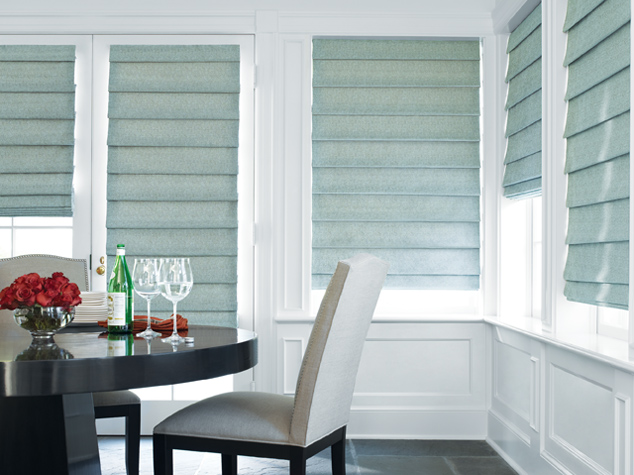
When choosing window coverings for your home, it’s important to assess your priorities and find a suitable product. Photo: Creative Window Fashions, Inc. ©2020
In the market for new window coverings? You might be surprised (and a little overwhelmed) by the sheer variety of options there are to choose from. To help you navigate this intimidating terrain, we’ve provided the following overview of window covering basics.
What to Look for in a Window Covering
When choosing window coverings for your home, it’s important to assess your priorities and find a suitable product. Here are some attributes to look for:
Energy efficiency
Some window coverings improve home energy efficiency by providing an exceptional level of insulation that keeps out both heat and cold.
Light control
If you’re a sensitive sleeper, you’ll want a window treatment that’s effective at blocking external light from entering your bedroom.
Privacy
Privacy is obviously a concern in bathrooms and bedrooms, but some homeowners want this trait for all the window coverings in their home.
Child safety
Some window treatments have cords that pose a strangulation hazard for young children. Many manufacturers offer cordless versions that reduce this risk.
Design style
In addition to functional considerations, you’ll want to choose a window covering that fits within the aesthetic scheme of your home décor.
Resale value
Some window coverings can increase your home’s resale value, which can be a desirable attribute if you’re planning to sell in the future.
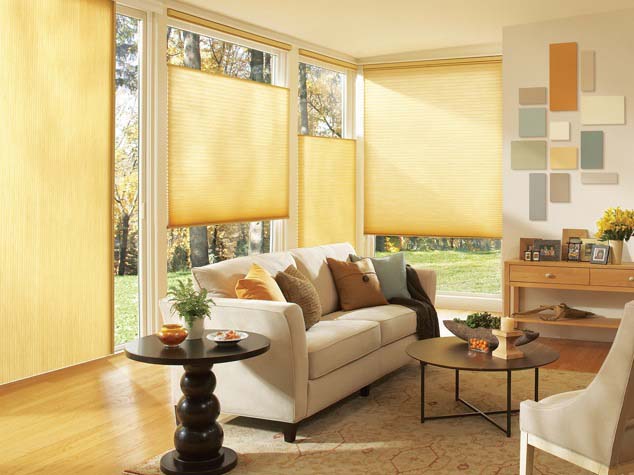
Photo: Creative Window Fashions, Inc. ©2020
Window Covering Options
Here are a few of the most popular window covering options available on the market today:
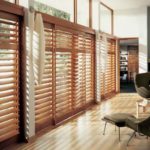 Plantation shutters
Plantation shutters
Plantation shutters offer an appealing combination of durability, energy efficiency and aesthetic beauty. Well-made shutters can last more than 20 years, which is several times the lifespan of other window treatments. Plantation shutters are available in a variety of materials, including vinyl, natural wood and composite (faux wood).
 Honeycomb (cellular) shades
Honeycomb (cellular) shades
Made with durable fabric, honeycomb shades are designed to provide maximum insulation and light control. Since they completely block incoming light, they’re a great choice for those who work nights or are sensitive to light intrusion. Honeycomb shades also come in hundreds of color options and are very affordable.
 Roller shades
Roller shades
Roller shades are a good option for those who need a window treatment that won’t obstruct the molding around their home’s windows. Like honeycomb shades, they provide good light control and insulation, and they’re available in a variety of colors.
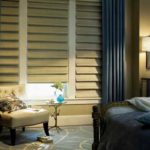 Roman shades
Roman shades
Custom-made from fine fabric, roman shades are one of the more expensive window treatment options, popular with homeowners who want to match fine furniture or go for a specific aesthetic. Roman shades have a tendency to collect dust, so those with allergy sensitivities should be aware of that.
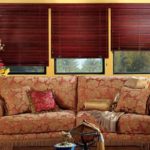 Wood/faux wood blinds
Wood/faux wood blinds
Wood blinds are an economical choice for those who want an attractive, energy-efficient window covering that won’t break the bank. For a low-maintenance option, choose faux wood blinds; they’re also a smart choice for bathrooms and other high-moisture areas.
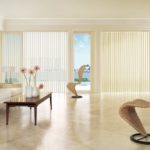 Vertical blinds
Vertical blinds
Vertical blinds function similarly to curtains, with hanging vanes that open and close from side to side. Advantages include versatility (they can be customized for nearly any scenario), ease of maintenance and affordability. The main drawback of vertical blinds is that the vanes can break off where they connect to the top of the headrail. However, replacement vanes can be purchased and easily reinstalled.
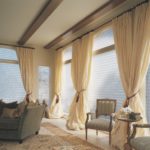 Drapes/curtains
Drapes/curtains
Drapes and curtains are classic window treatment styles that have been used in homes for centuries. While either can add an aesthetically pleasing touch to a living space, drapes’ thicker fabric makes them particularly effective for light control. The main drawback of drapes and curtains is their bulkiness, which makes them more likely to impose upon window views and dictate where furniture can go.

Photo: PKS Interiors ©2020
DIY Window Covering Tips
How to replace a broken curtain rod carrier
A curtain rod contains multiple carriers—small, plastic clips that hold the hooks upon which the curtains hang. At the end of the rod, there’s an arm that keeps these carriers contained. If you need to replace one or more broken carriers, you can release this arm and slide the carriers out. After removing the broken ones, you can insert new replacement carriers. Once you’re finished, simply close the arm to lock in the carriers and your curtain rod is fixed.
To see this task performed in person, watch this video by Peyman Sadigh of PKS Interiors.
How to remove a shutter panel

If your home has window shutters, you may find that you need to remove a shutter panel in order to do some painting, cleaning or repairs. This involves a procedure similar to removing a door. Use a nail set to push the bottommost hinge pin upward through the hinge and pull the nail completely out. Repeat this step with the remaining hinges. After you’ve removed all the nails, the panel is free to pull out—just rotate it toward the hinge and it’ll come right off.
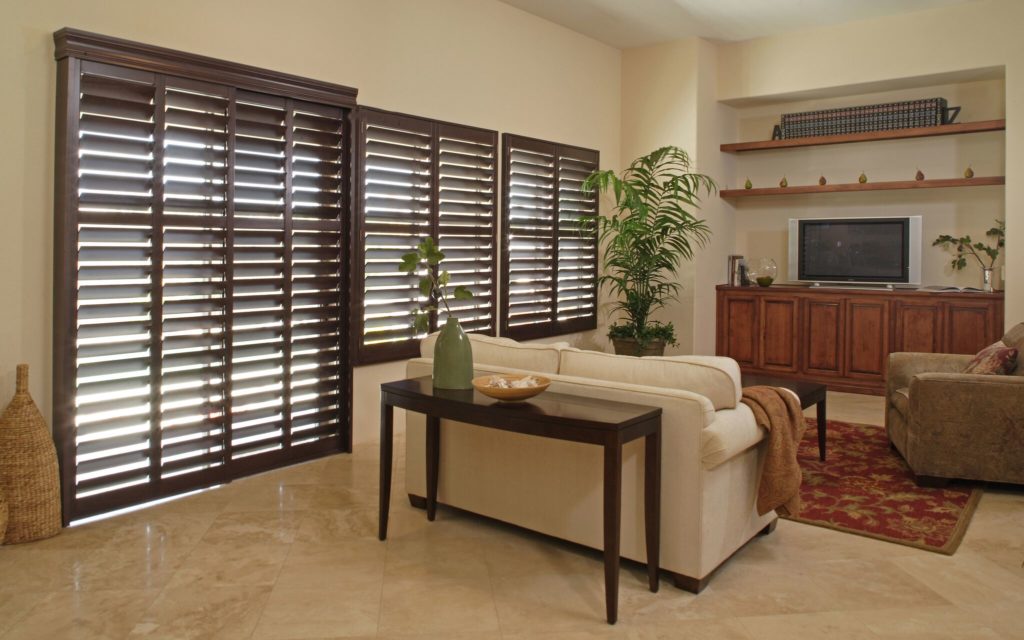
Photo: Magna Shutters ©2020
Frequently Asked Questions About Window Coverings
Q: Will window coverings add to my home’s resale value?
A: According to Duane Vos of Creative Window Fashions, Inc., the only window covering that’s sure to add resale value to a home is shutters. “Once they’re installed, shutters are considered a ‘fixed asset,’ which puts them in the same league as other permanent fixtures like floors and countertops,” he explains. “In fact, the value shutters add to a home often exceeds the cost of the shutters themselves. It’s not uncommon for $7,000 worth of faux wood or vinyl shutters to translate to $10,000 added onto a home’s appraisal.”
Q: What are some things to consider when choosing drapes?
A: “When choosing drapes, you have to consider a lot more than just the color of the fabric,” says Amanda Lafferty of National Blinds & Flooring Inc. “If you’re going purely for aesthetics, a linen or sheer fabric will do, but some people prefer materials like velvet or wool, which offer better light-filtering qualities.” Ms. Lafferty says you should also consider how you want to line the fabric. “In addition to standard linings, there are specialty linings available such as blackout lining and interlining, the latter of which provides superior sound dampening and insulation.”
Q: Which window treatments provide the best privacy control?
A: Drapes, roman shades, vertical blinds and honeycomb (cellular) shades all provide good privacy control. Honeycomb shades offer a unique bonus feature: Because of their dual-fold character, they can be lowered from the top-down, which provides privacy on the lower half of the window while allowing light to enter from the top.
Q: Can window coverings be automated?
A: Yes, many types of window coverings are compatible with home automation systems. For example, PowerView® Motorization by Hunter Douglas can be used to automate window shades and set them to a daily opening/closing schedule.
Q: What’s a good window treatment option for households with small children?
A: Due to the safety hazard posed by cords used for shades and other window treatments, a cordless product is best for homes with small children. A couple of good options are cordless cellular shades and vertical blinds. Besides being cordless, PVC vertical blinds are durable and easy to clean.
Find a Diamond Certified window covering provider in your area
One Response
Leave a Reply
You must be logged in to post a comment.

Yeah, I agree these window coverings like blinds, curtains, shades and shutters have their own benefits and have little maintenance. These tips helps in many ways. Thanks for the wonderful post.